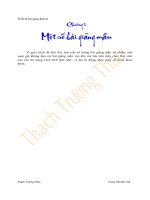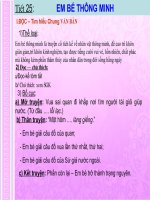Bài giảng điện tử IELTS 5 6 unit 3
Bạn đang xem bản rút gọn của tài liệu. Xem và tải ngay bản đầy đủ của tài liệu tại đây (8.3 MB, 52 trang )
Getting the message across
1
2
Study
1
Work in pairs. You are going to hear a student talking to her course tutor about an assignment. Before you listen,
match the words (1-9) with their definitions (a-i) .
2
3
4
4
5
6
D
clearly sequenced and presented
F
went down well/really like that one
A
topic’s certainly more closely linked
C
mobile phone(s)
mini-lectures/wouldn’t have to spend much time
digital recorder(s)
1
Work in small groups. You are going to read an article about different theories on how babies learn to talk. Before you read,
look at the speech bubbles below .
1
Work in small groups. You are going to read an article about different theories on how babies learn to talk. Before you read,
look at the speech bubbles below .
2
Work in pairs. Read the title and sub heading of the passage quickly. What do you expect t o read about in the article?
how babies learn to talk and the stages they go through.
ResearchHYPOTHESIS
METHOD
EXPERIMENT
based
arguments
CONCLUSION
FINDING
RESULTS
3
When
their
brains
are
ready.
….
….
….
4
Work in pairs. Look at the underlining in Question 1 below, then read the first paragraph of the passage. What is the
answer?
Yes
5
Now underline the words in Questions 2- 4 that help you find the right place in the pass age . Then answer Questions
2- 4 .
2. Behaviorists of the
early 20th century
Yes
argued that children
learn to speak by
copying adults .
3. Children have more
conversations with
adults than with other
NG
children.
4. Scientists have found
it easy to work out why
babies use one-word
sentences.
No
6
Work in pairs. Read the title of the summary below and use this to find the right part of the passage. Look at Question 5.
Why is 'C' correct?
6
Work in pairs. Read the title of the summary below and use this to find the right part of the passage. Look at Question 5.
Why is 'C' correct?
7
B
7
B
A
F
E
8
8
9
1









